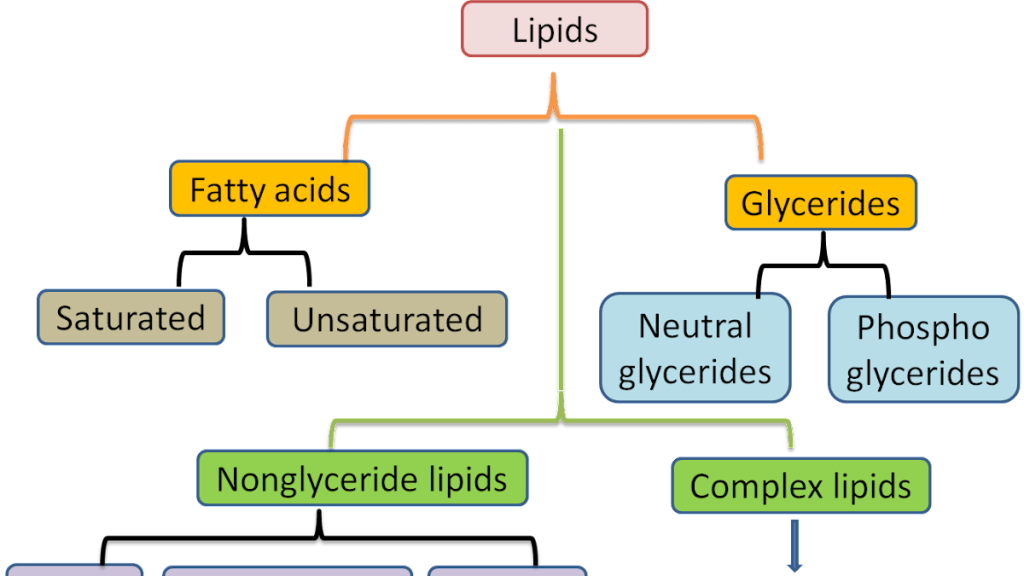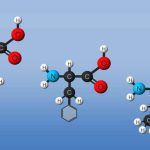Within these two major classes of lipids, there are several specific types of lipids important to live, including fatty acids, triglycerides, glycerophospholipids, sphingolipids, and steroids. These are broadly classified as simple lipids and complex lipids.
Also read: Biomolecules in Living Organisms
Simple Lipids
Esters of fatty acids with various alcohols.
- Fats: Esters of fatty acids with glycerol. Oils are fats in the liquid state.
- Waxes: Esters of fatty acids with higher molecular weight monohydric alcohols
Complex Lipids
Esters of fatty acids containing groups in addition to alcohol and a fatty acid.
- Phospholipids: Lipids containing, in addition to fatty acids and alcohol, a phosphoric acid residue. They frequently have nitrogen-containing bases and other substituents, eg, in glycerophospholipids the alcohol is glycerol and in sphingophospholipids the alcohol is sphingosine.
- Glycolipids (glycosphingolipids): Lipids containing a fatty acid, sphingosine, and carbohydrate.
- Other complex lipids: Lipids such as sulfolipids and amino lipids. Lipoproteins may also be placed in this category
Precursor and Derived Lipids
These include fatty acids, glycerol, steroids, other alcohols, fatty aldehydes, and ketone bodies, hydrocarbons, lipid-soluble vitamins, and hormones. Because they are uncharged, acylglycerols (glycerides), cholesterol, and cholesteryl esters are termed neutral lipids. These compounds are produced by the hydrolysis of simple and complex lipids.
Some of the different types of lipids are described below in detail.
Fatty Acids
Fatty acids are carboxylic acids (or organic acid), often with long aliphatic tails (long chains), either saturated or unsaturated.
- Saturated fatty acids
When a fatty acid is saturated it is an indication that there are no carbon-carbon double bonds. The saturated fatty acids have higher melting points than unsaturated acids of the corresponding size due to their ability to pack their molecules together thus leading to a straight rod-like shape.
- Unsaturated fatty acids
If a fatty acid has more than one double bond then this is an indication that it is an unsaturated fatty acid.
“Most naturally occurring fatty acids contain an even number of carbon atoms and are unbranched.”
Unsaturated fatty acids, on the other hand, have a cis-double bond(s) that create a kink in their structure which doesn’t allow them to group their molecules in straight rod-like shape.
Role of Fats
Fats play several major roles in our body. Some of the important roles of fats are mentioned below:
- Fats incorrect amounts are necessary for the proper functioning of our body.
- Many fat-soluble vitamins need to be associated with fats in order to be effectively absorbed by the body.
- They also provide insulation to the body.
- They are an efficient way to store energy for longer periods.
Waxes
Waxes are “esters” (an organic compound made by replacing the hydrogen with acid by an alkyl or another organic group) formed from long-chain carboxylic acids and long-alcohols.
Waxes are seen all over in nature. The leaves and fruits of many plants have waxy coatings, which may protect them from dehydration and small predators.
The feathers of birds and the fur of some animals have similar coatings which serve as a water repellent.
Carnauba wax is valued for its toughness and water resistance(great for car wax).
Phospholipids

Membranes are chiefly made of phospholipids which are Phosphoacylglycerols.
Triacylglycerols and phosphoacylglycerols are similar however the terminal OH group of the phosphoacylglycerol is esterified with phosphoric acid instead of fatty acid which leads to the formation of phosphatidic acid.
The name phospholipid comes from the fact that phosphoacylglycerols are lipids that contain a phosphate group.
Steroids

The chemical messengers in our bodies are known as hormones which are organic compounds synthesized in glands and delivered by the bloodstream to certain tissues in order to stimulate or inhibit the desired process.
Steroids are a type of hormone which is usually recognized by their tetracyclic skeleton, consisting of three fused six-membered and one five-membered ring, as shown in the diagram above. The four rings are designated as A, B, C & D as noted in blue, and the numbers in red represent the carbons.
Cholesterol
- Cholesterol is waxy like substance, found only in animal source foods. Triglycerides, LDL, HDL, VLDL are different types of cholesterol found in the blood cells.
- Cholesterol is an important lipid found in the cell membrane. It is a sterol, which means that cholesterol is a combination of steroid and alcohol. In the human body, cholesterol is synthesized in the liver.
- These compounds are biosynthesized by all living cells and are essential for the structural component of the cell membrane.
- In the cell membrane, the steroid ring structure of cholesterol provides a rigid hydrophobic structure that helps boost the rigidity of the cell membrane. Without cholesterol, the cell membrane would be too fluid.
- It is an important component of cell membranes and is also the basis for the synthesis of other steroids, including the sex hormones estradiol and testosterone, as well as other steroids such as cortisone and vitamin D.
Examples of Lipids
There are different types of lipids. Some examples of lipids include butter, ghee, vegetable oil, cheese, cholesterol and other steroids, waxes, phospholipids, and fat-soluble vitamins. All these compounds have similar features, i.e. insoluble in water and soluble in organic solvents, etc.


